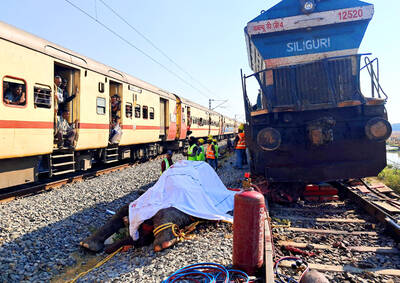If tycoon Yang Bin (
Bus No. 260 departs at regular intervals from outside the Intermediate People's Court in the northeastern city of Shenyang heading for Holland Village, a sprawling complex of apartment buildings, offices and greenhouses.
The side of the bus carries a large advertisement, still in bright colors, urging people to "Move to Holland Village" and showing the 219-hectare real estate development's hallmark Dutch windmills and Baroque castles.
No one has followed the advertisement's advice since Dutch-Chinese businessman Yang fell foul of the law in September last year, and many have moved out.
"There are only about 60 security guards left here," said one young guard dressed in a gray uniform. "No one else goes to work here anymore."
Attention this week is focused on Yang's trial, which is expected to end in a verdict today with a long jail sentence for the 40-year-old businessman.
But next on many creditors' list of priorities is the question of how to recoup some of the money they lent to Yang's collapsed empire.
Auctioning off Holland Village could play a key part in making them happy, sources following Yang's trial have said.
Yang was thinking big when he tried to fullfil his dream of bringing home a piece of the Netherlands, where he worked and studied and eventually obtained citizenship.
It was to have been a garden of peace and refined taste, where residents could relax behind guarded walls and forget they were in the middle of northeast China's dreary northeastern rustbelt.
In the spirit of a new China where young entrepreneurs were allowed to foster bold ideas and turn them into practice, Yang planned to invest 1.8 billion yuan (US$200 million) into a dream-like place where people could live and shop in luxurious surroundings.
Even in Yang's heyday, Holland Village never escaped looking slightly bizarre, resembling a kind of fairytale Netherlands thought up by an architect who appeared to know the country from coffeetable books.
And more than eight months after Yang was placed under house arrest suspected of financial irregularities, the luster of the project has faded fast.
Decrepit and depopulated, it now looks almost as eccentric as the idea of a North Korean capitalist trade zone that Pyongyang picked Yang to run in September last year, shortly before his detention by Chinese authorities.
A clock on a replica of Amsterdam train station in the center of the village has stopped at 3:15pm, and it seems time has stood still all around it.
The vast flowerbeds that once adorned the sides of the street have disappeared, as has the water in the moats, along with the black and white swans.
The broad avenue separating Holland Village in two is rapidly deteriorating into a dirt road, while grass sticks through cracks in the pavement.
Panes are missing in many of the windows of the two-storey buildings that should have housed cozy little shops, and banners that previously welcomed visitors are torn to shreds.
Apart from being the residence for Shenyang's wealthy classes, Holland Village was also to have served Yang's vast horticultural business.
Extended rows of oversized greenhouses were built in a corner of the complex, intended for mass production of orchids and chrysanthemums.
Now, the weeds in the ditches outside the greenhouses grow more plentiful than any of the flowers inside, left untended for months.
"There's no water and power supply except for in our living quarters," said a security guard.
Even if nothing else works in Holland Village, the security apparatus is apparetnly still up and running.
"No one is allowed to roam around here," said a plain-clothes police officer, stepping out of his four-wheel drive.
"No photos and no notes, please. That's an order from the city government," he said.

REVENGE: Trump said he had the support of the Syrian government for the strikes, which took place in response to an Islamic State attack on US soldiers last week The US launched large-scale airstrikes on more than 70 targets across Syria, the Pentagon said on Friday, fulfilling US President Donald Trump’s vow to strike back after the killing of two US soldiers. “This is not the beginning of a war — it is a declaration of vengeance,” US Secretary of Defense Pete Hegseth wrote on social media. “Today, we hunted and we killed our enemies. Lots of them. And we will continue.” The US Central Command said that fighter jets, attack helicopters and artillery targeted ISIS infrastructure and weapon sites. “All terrorists who are evil enough to attack Americans are hereby warned

‘POLITICAL LOYALTY’: The move breaks with decades of precedent among US administrations, which have tended to leave career ambassadors in their posts US President Donald Trump’s administration has ordered dozens of US ambassadors to step down, people familiar with the matter said, a precedent-breaking recall that would leave embassies abroad without US Senate-confirmed leadership. The envoys, career diplomats who were almost all named to their jobs under former US president Joe Biden, were told over the phone in the past few days they needed to depart in the next few weeks, the people said. They would not be fired, but finding new roles would be a challenge given that many are far along in their careers and opportunities for senior diplomats can

Seven wild Asiatic elephants were killed and a calf was injured when a high-speed passenger train collided with a herd crossing the tracks in India’s northeastern state of Assam early yesterday, local authorities said. The train driver spotted the herd of about 100 elephants and used the emergency brakes, but the train still hit some of the animals, Indian Railways spokesman Kapinjal Kishore Sharma told reporters. Five train coaches and the engine derailed following the impact, but there were no human casualties, Sharma said. Veterinarians carried out autopsies on the dead elephants, which were to be buried later in the day. The accident site

RUSHED: The US pushed for the October deal to be ready for a ceremony with Trump, but sometimes it takes time to create an agreement that can hold, a Thai official said Defense officials from Thailand and Cambodia are to meet tomorrow to discuss the possibility of resuming a ceasefire between the two countries, Thailand’s top diplomat said yesterday, as border fighting entered a third week. A ceasefire agreement in October was rushed to ensure it could be witnessed by US President Donald Trump and lacked sufficient details to ensure the deal to end the armed conflict would hold, Thai Minister of Foreign Affairs Sihasak Phuangketkeow said after an ASEAN foreign ministers’ meeting in Kuala Lumpur. The two countries agreed to hold talks using their General Border Committee, an established bilateral mechanism, with Thailand